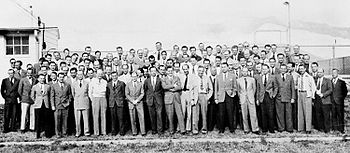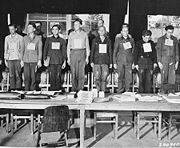Central Works (German: Mittelwerk) - Picture

|
|
Mittelwerk
Picture - location: Nordhausen, Thuringia
: US soldier and captured Mittelwerk V-2 rocket motor
Type: Subterranean bunker
Built: Completed 1943
Built by: Mittelwerk GmbH
In use: 1943-1945
Open to
the public: Museum in the southern part of Tunnel A
Central Works (German: Mittelwerk) was a World War II factory that used Mittelbau-Dora forced labor in 2 main tunnels (1.6 km each) in the Kohnstein. The underground facility produced V-2 rockets, V-1 flying bombs, and other Nazi weapons.
Mittelwerk GmbH
On 19 October 1943, the government Central Works Ltd (German: Mittelwerk GmbH) company was issued War Contract No. 0011-5565/43 by General Emil Leeb, head of the Army Weapons Office, for 12,000 A-4 missiles at 40,000 Reichsmarks each. Mittelwerk GmbH also headed sites for V-2 rocket development and testing at Schlier (Project Zement) and Lehesten. Beginning in May 1944, Georg Rickhey was the Mittelwerk general manager, Albin Sawatzki was the Mittelwerk technical director over both Arthur Rudolph's Technical Division (with deputy Karl Seidenstuecker) and Hans Lindenberg's 50 engineers of the quality control group located at Ilfeld. Other Mittelwerk/Ilfield engineers included Magnus von Braun in turbopump production, Guenther Haukohl who supervised V-2 production after helping design the assembly line, Eric Ball (assembly line), Hans Fridrich, Hans Palaoro and Rudolph Schlidt. The facility had a communications staff under Captain Dr Kx¼hle, an Administrative Division run by Bx¶rner under Mittelwerk board member Otto Karl Bersch, and a Prisoner Labor Supply office (Brozsat). Hannelore Bannasch was Sawatzki's secretary.
Other projects
In July 1944, Hans Kammler ordered the North Works (Nordwerke) to use cross-tunnels 1-20 for a Junkers jet and piston engine factory, leaving cross-tunnels 21-46 for Mittelwerk GmbH. During February-April 1945, the Nordhausen plant built Taifun antiaircraft missiles and Heinkel He 162 jet fighters and put into operation a liquid oxygen plant. The plant was the Eber project and used equipment evacuated from the x‰perlecques bunker and elsewhere to build Heylandt liquid oxygen generators (the 15 generators were nearly complete when the site was captured.) The Mittelwerk also contained equipment for producing jet fuel, and in an emergency 1944 decentralization program, the Geilenberg Special Staff started the 'Cuckoo' project underground oil plant to be "carved out of the Himmelsburg" North of the Mittelwerk. V-1 flying bomb assembly began during October/November 1944 in the South end of tunnel A. At the end of January 1945, 51 V-1s were shipped from a dispersed Fieseler factory in Upper Bavaria (code name Cham) to the Nordhausen plant for completion. After a second V-1 factory at Burg was closed, the Mittelwerk Werk II in February 1945 was the only factory producing V-1 flying bombs, and a total of 2,275 V-1s were built by Werk II from September 1944 until April 1945.
The Mission had been told that Nordhausen was a large underground factory, and that they would see extraordinary production methods, but they had no idea that they would be brought face-to-face with such an undertaking. The reaction of the Mission to this visit ... was one of the utmost revulsion and disgust. This factory is the epitome of megalomaniac production and robot efficiency and layout. Everything was ruthlessly executed with utter disregard for humanitarian considerations. The record of Nordhausen is a most unenviable one, and we were told that 250 of the slave workers perished every day, due to overwork and malnutrition. Some of the Mission visited a slave workers' encampment, talked to a Dutch doctor who had been there throughout the war, and saw many of the wretched inmates, who were in an apalling state, although receiving every medical attention now. They also saw stretchers heavily saturated in blood, a room in which there was a slab on which the bodies were drained of blood, and the incinerators in which the bodies were burnt. These are all facts which require to be seen to be fully appreciated. This terrible and devilish place has now passed into Russian hands and it is sincerely hoped that our allies will deal with it in a proper and adequate manner.
Evacuation
In late February 1945, the Allied Chiefs of Staff discussed a proposed attack on the Nordhausen plant with a highly flammable petroleum-soap mixture that had been used in the Pacific theatre to deeply penetrate buried strongpoints and scourge them with intense heat. Instead, the nearby city of Nordhausen was attacked with conventional bombs by two RAF Bomber Command night bombings on 2/3 & 3/4 April, the Mittelbau-Dora forced labor was evacuated on 4 April, and scientists evacuated to the Alpenfestung (English: Alpine Fortress). Contrary to Hitler's order requiring Demolitions on Reich Territory, the Nordhausen plant was evacuated without damage.
Aftermath
Having been warned to "expect something a little unusual in the Nordhausen area", and after previously entering the Nordhausen plant from the North through the Junkers Nordwerke, U.S. 3rd Armored Division and 104th Infantry Divisions reached the city of Nordhausen on 11 April 1945 and discovered the dead and sick of the Boelcke Kaserne barracks. Compared to the V-2 rocket casualties (2,541 killed, 5,923 injured), an estimated 20,000 Mittelbau-Dora forced laborers died: 9000 died from exhaustion and collapse, 350 were hanged (including 200 for sabotage), and the remainder died from disease or starvation (or were shot).
Special Mission V-2

Picture - A few of these Operation Paperclip had been at the Mittelwerk.
On 22 May 1945, US Army Special Mission V-2 shipped the first trainload of rocket parts for use in projects such as Operation Sandy, Operation Blossom and, at the White Sands Proving Grounds, the Hermes project. The Nordhausen area was to become part of the Soviet zone of occupation, and Soviet Army officers arrived to tour the Nordhausen plant on 26 May 1945. In June 1945, the US Army left the Nordhausen plant as required by JCS Directive 1067/14, with parts, machine tools, and documents (including blueprints for the projected A-9/A-10 intercontinental missile) left for the Soviets. The Red Army occupied the Mittelwerk on 5 July 1945 and demolished both of the entrances of the tunnel system in the summer of 1948.
Andrae Trial

Picture - 16 of 19 Andrae defendants
The 1947 Andrae Trial convicted concentration camp kapos, while 3 scientists of the V-2 rocket program were implicated (2 after the trial) and exonerated of Nazi war crimes at the Mittelwerk. On 19 May 1947, the former head of the Mittelwerk facility, Georg Rickhey, was extradited to Germany from Wright Field in the U.S. and acquitted of war crimes at the 1947 Andrae trial. Arthur Rudolph was neither tried nor charged with any war crime, but decades later was deported from the US, and then exonerated by a German investigation and granted German citizenship. Wernher von Braun, the Technical Director of a separate facility at Peenemx¼nde, visited the Mittelwerk on 25 January 1944, and a 1991 author alleged he witnessed Mittelwerk and Buchenwald war crimes.
Ruins
After a new entrance tunnel had been dug to former rail Tunnel A in 1995, 710 meters of the tunnel system were opened for visitors. Large parts of the system are flooded by ground water, while other parts have collapsed. After the reunification of Germany the tunnels were frequently looted by treasure seekers who gained access via the private mine in the north of the Kohnstein. Willi Kramer, a German archaeologist and scientist who dived in the tunnel system in 1992 and 1998, estimated that 70 tons of material was stolen. Access through these entrances was not secured until 2004, when the mine went into insolvency.
Map
^Note 1 : Additional Nazi Germany plans for V-2 rocket plants (the Southern Works near Friedrichshafen and the Eastern Works near Riga) were never fulfilled.
"Heavy Crossbow" Installations: Brécourt • Mimoyecques • Siracourt • Sx¶ttevast • Watten • Wizernes No Ball sites: V-1 facilities • V-2 facilities
Barrage balloon • Pathfinders • Bombs: Aphrodite, Grand Slam, Tallboy •
Mittelwerk Pictures and Mittelwerk for Sale.
Living Warbirds: The best warbirds DVD series.
Source: WikiPedia